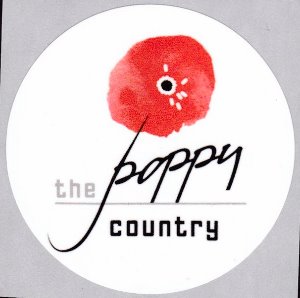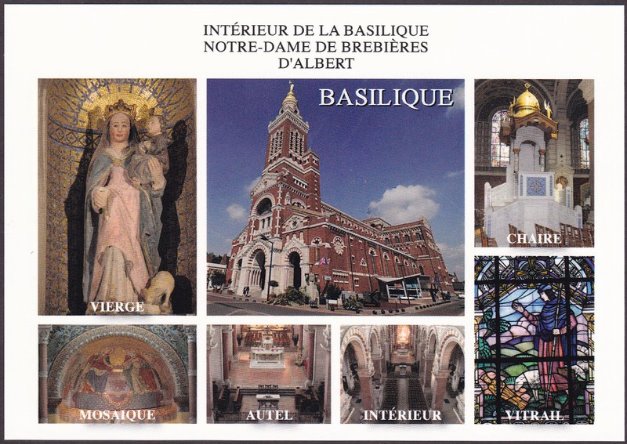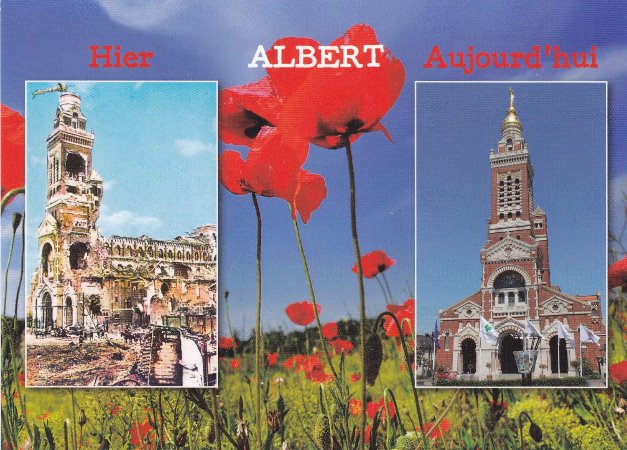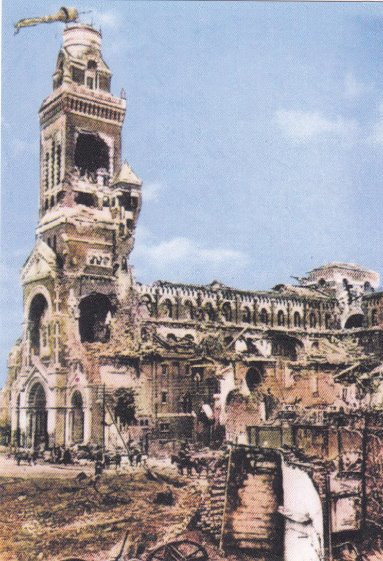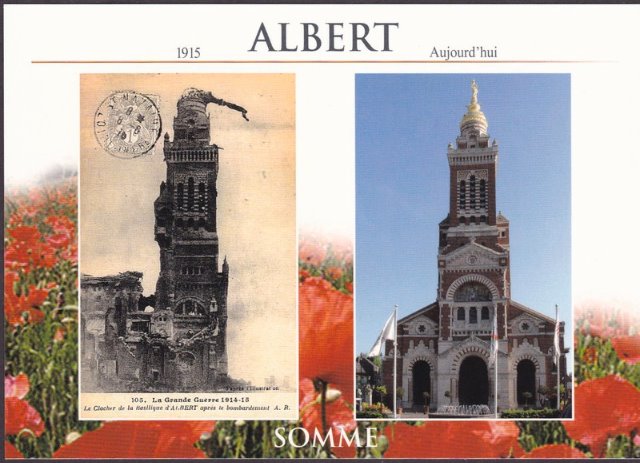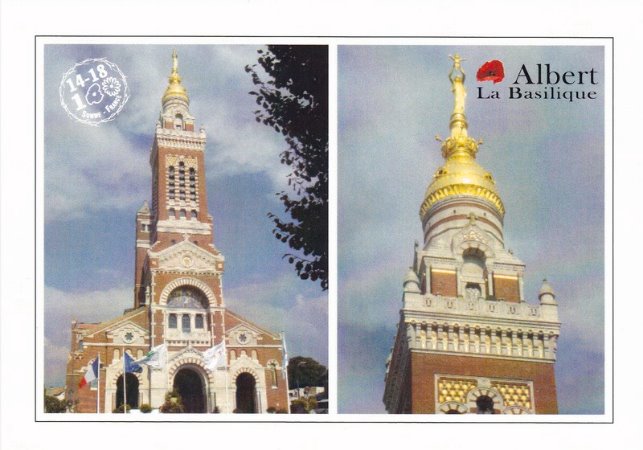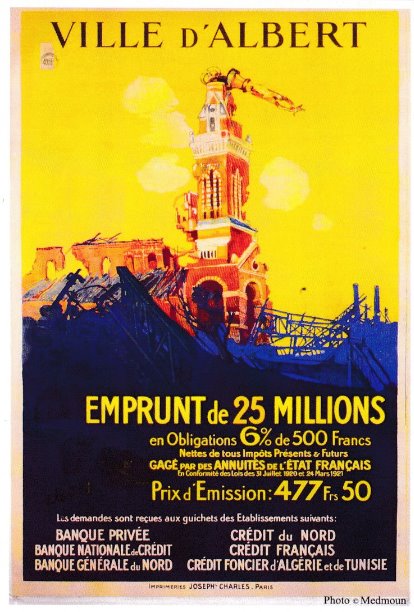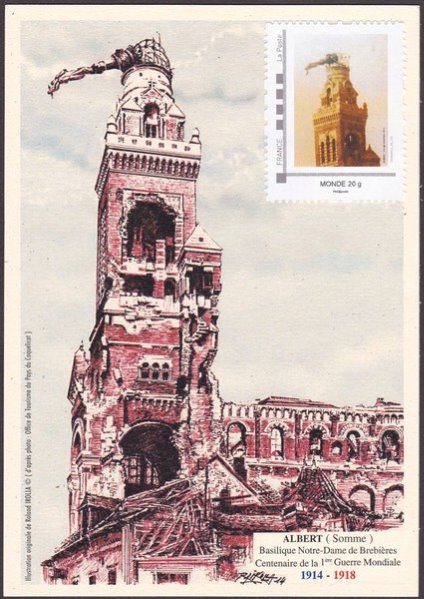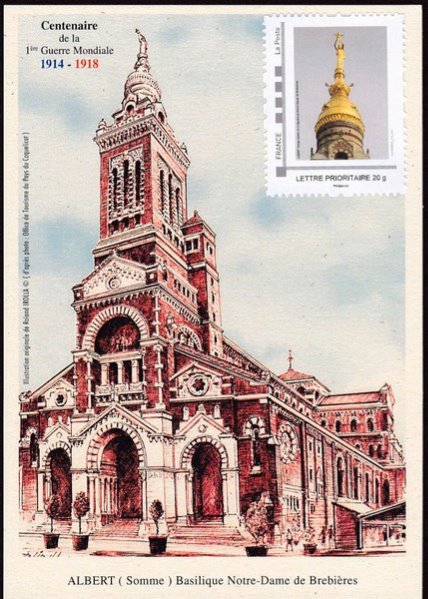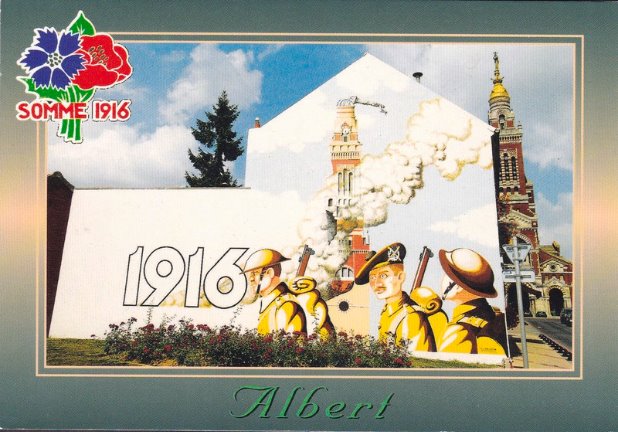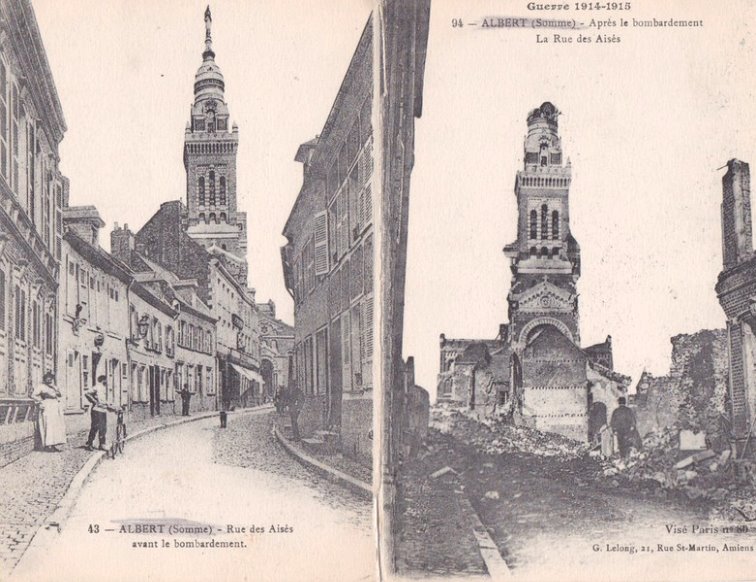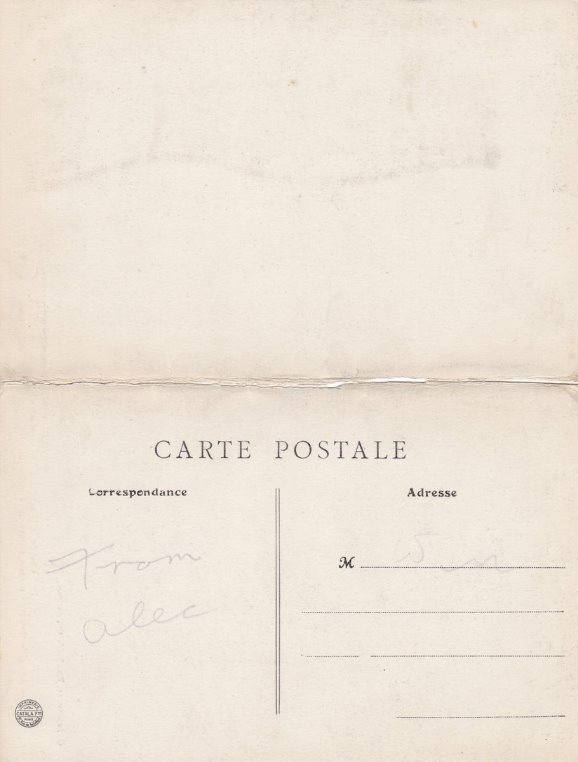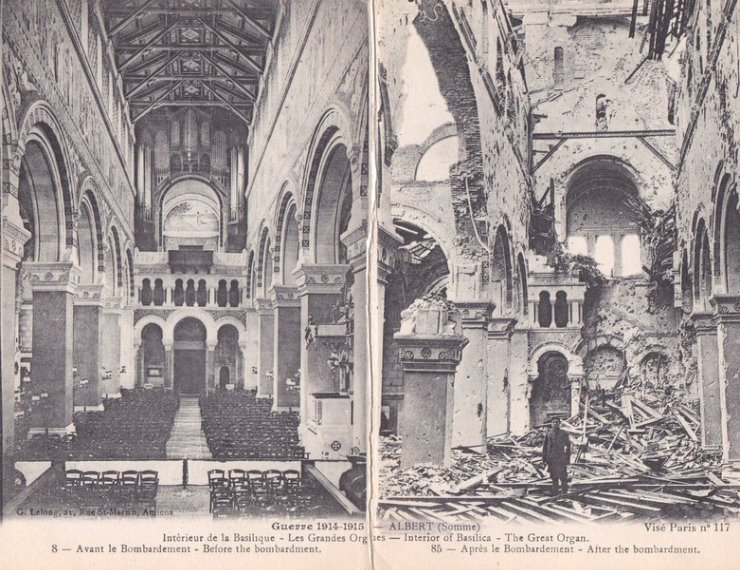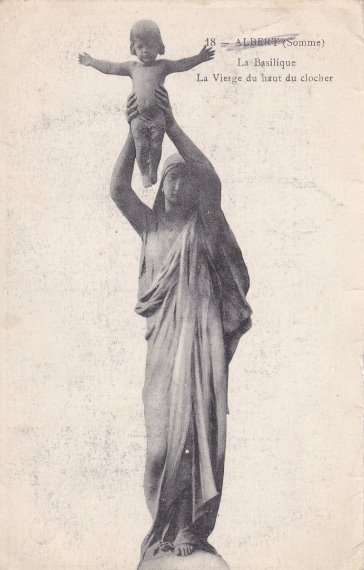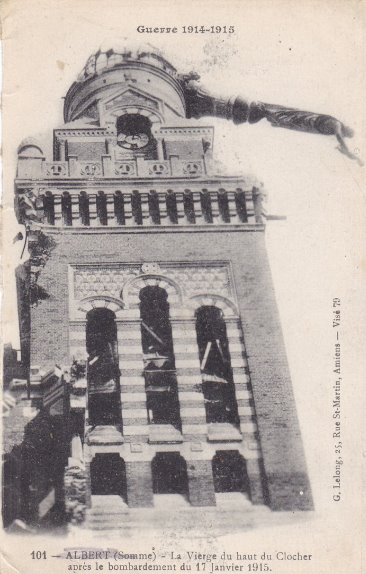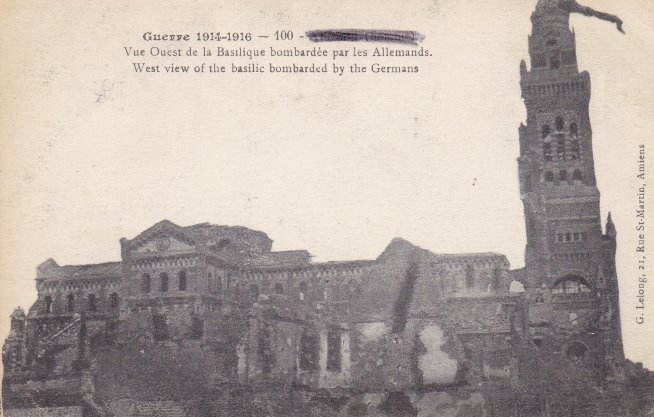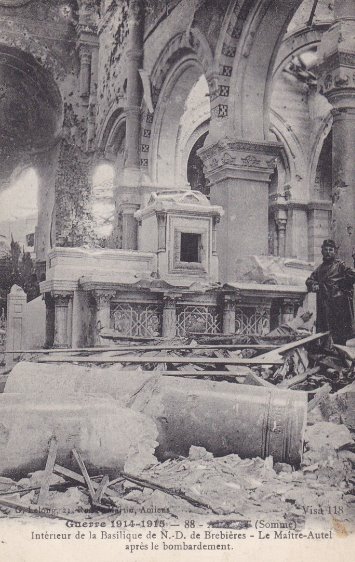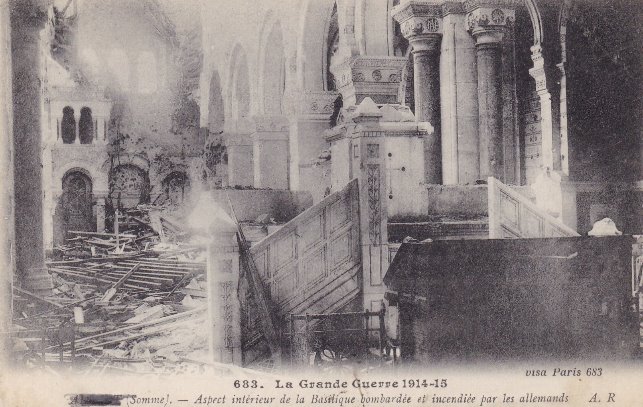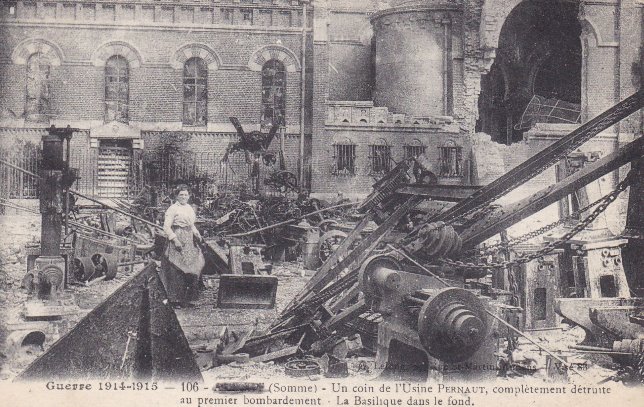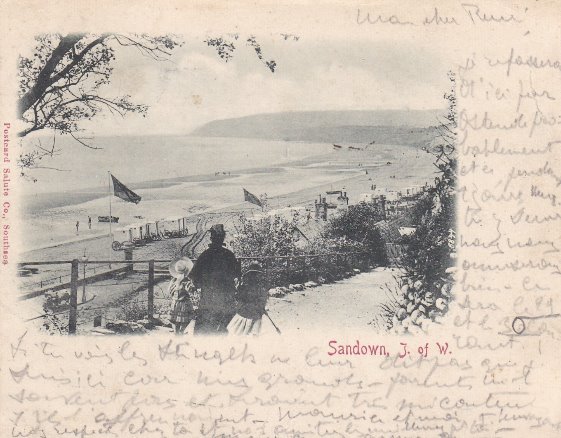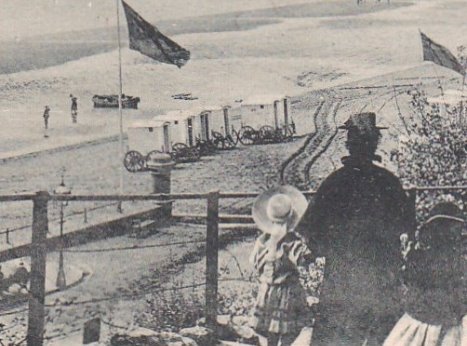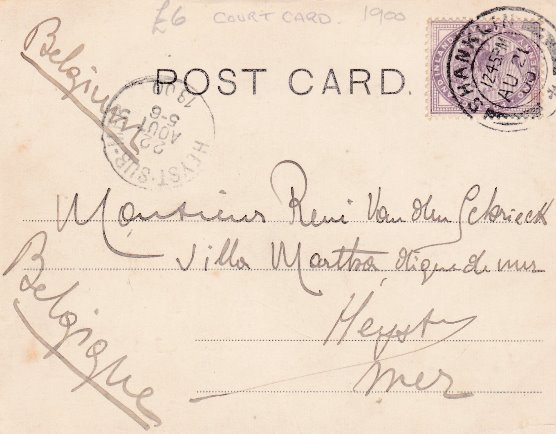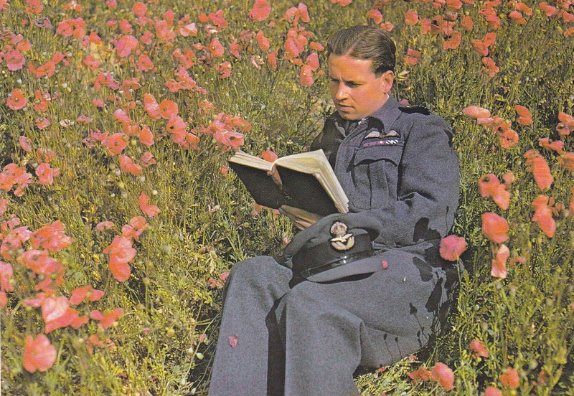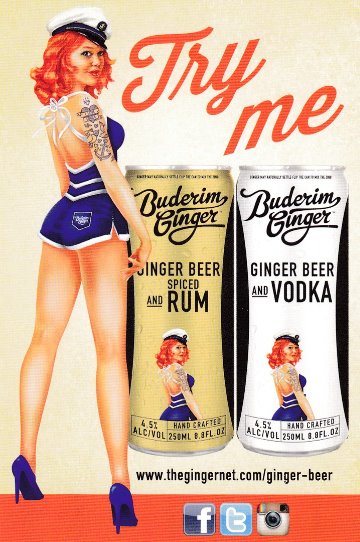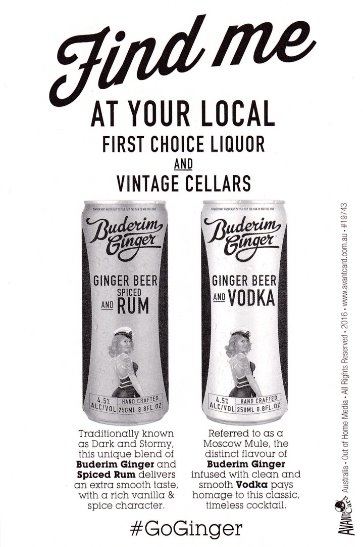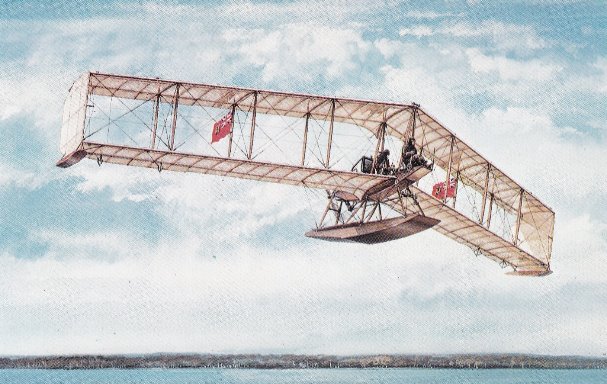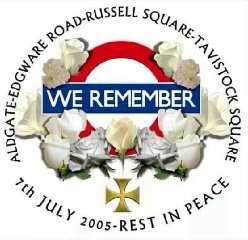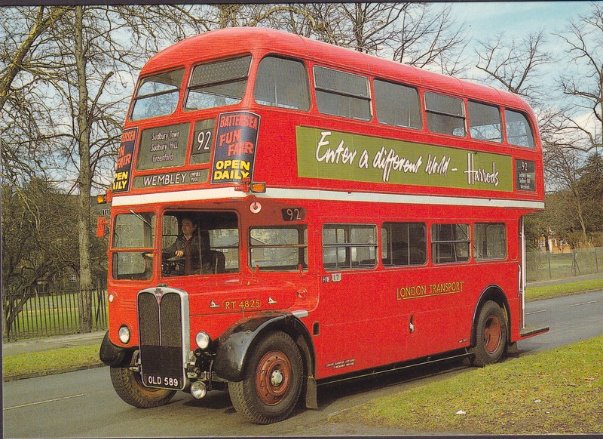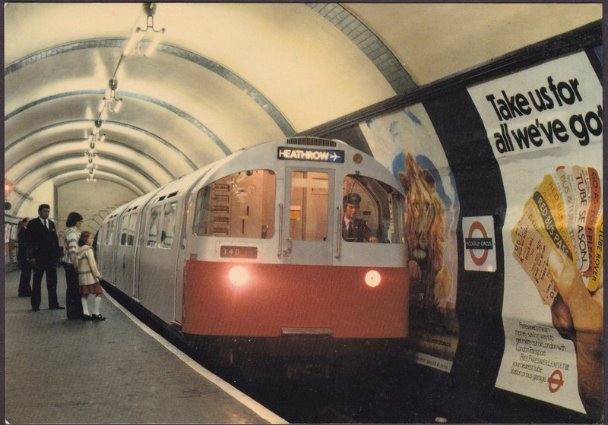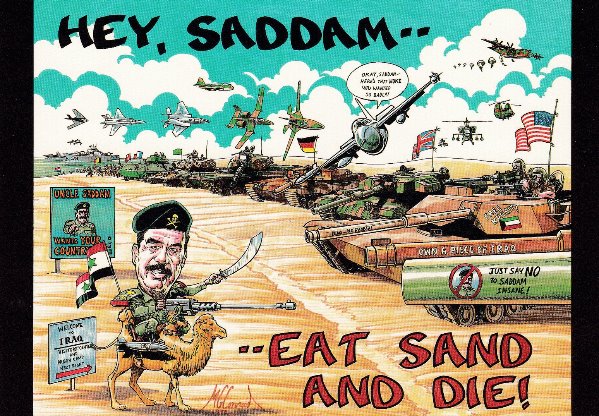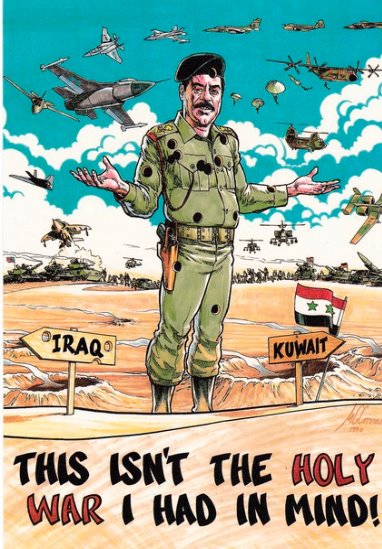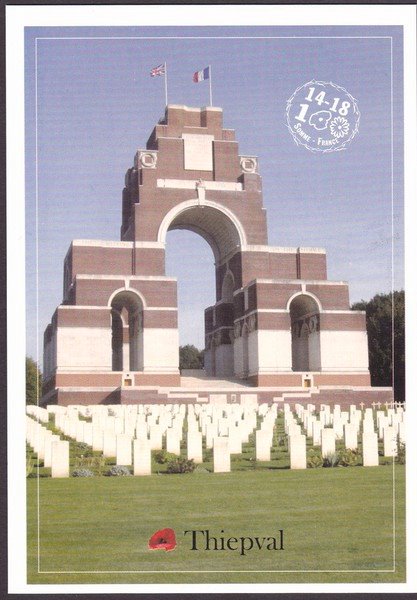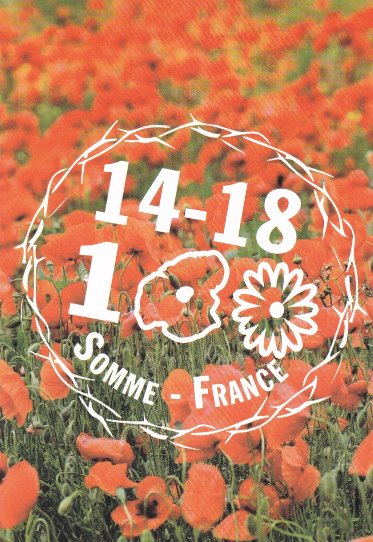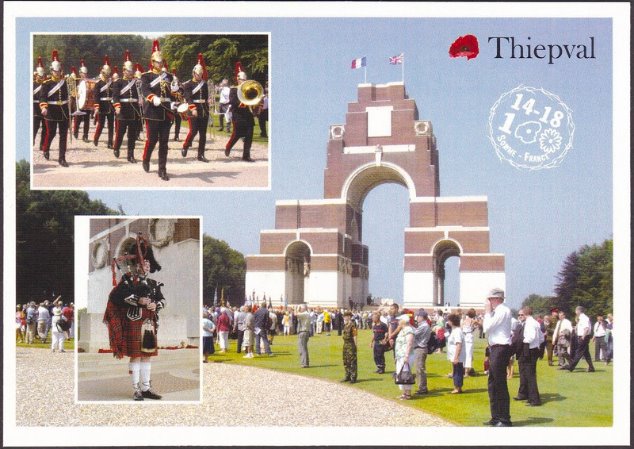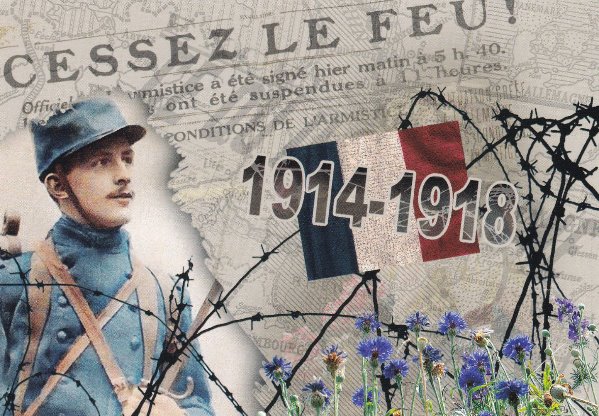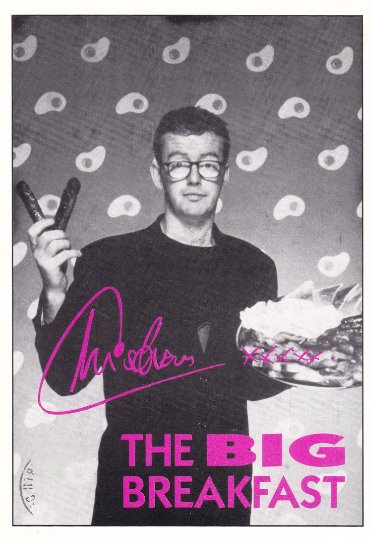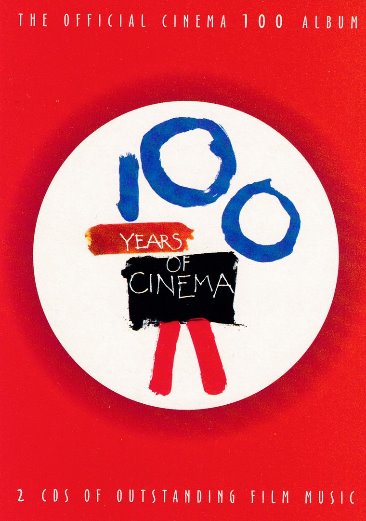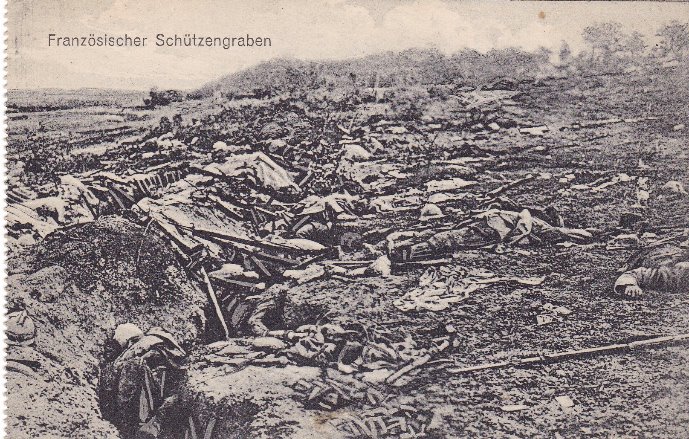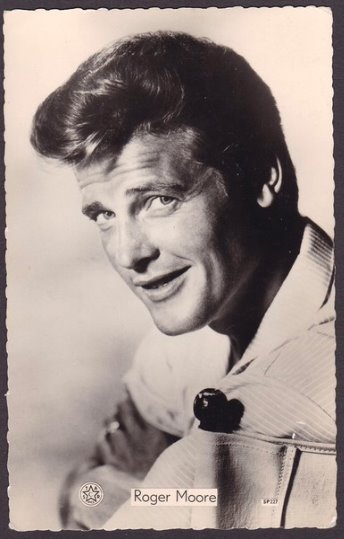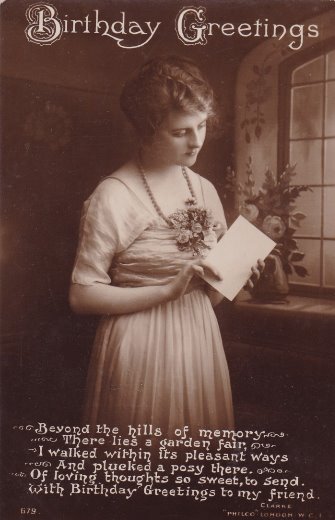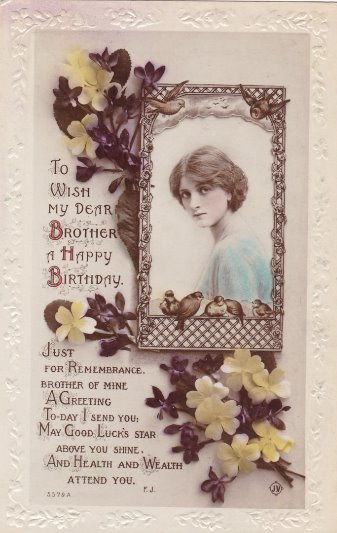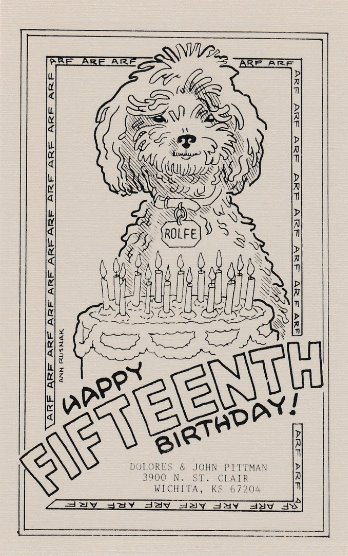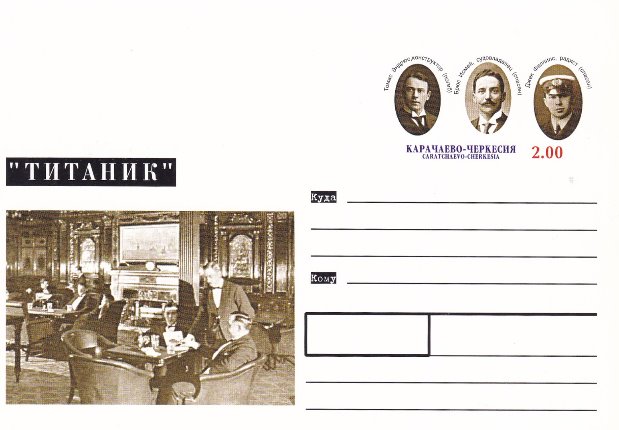HIER – ALBERT – AUJOURD ‘HUI
Published by
Editions COULEUR LOCALE
Ref: ALVB 02
This modern postcard shows an image (left side) of the Basilica during the first world war after it had been shelled and the golden virgin statue at the top had been knocked over on to its side, making it seem to hand precariously. The photo on the right shows a modern image of the reconstructed Basilica.
The statue depicts Mary and the infant Jesus and was designed by sculptor Albert Roze, and was called the ‘Golden Virgin’.
The Basilica was shelled on the 15th January 1915 (I have a postcard that says this was on 17th January – so this may be wrong) and, as stated above, the statue fell to one side, almost hanging horizontally.
HIER – ALBERT – AUJOURD ‘HUI
Published by
Editions COULEUR LOCALE
Ref: ALVB 02
This modern postcard shows an image (left side) of the Basilica during the first world war after it had been shelled and the golden virgin statue at the top had been knocked over on to its side, making it seem to hand precariously. The photo on the right shows a modern image of the reconstructed Basilica.
The statue depicts Mary and the infant Jesus and was designed by sculptor Albert Roze, and was called the ‘Golden Virgin’.
The Basilica was shelled on the 15th January 1915 (I have a postcard that says this was on 17th January – so this may be wrong) and, as stated above, the statue fell to one side, almost hanging horizontally.
ALBERT (FRANCE 80300 SOMME)
The Basilic after the first Bombardments (1916)
Imp VAILLANT - 80300 ALBERT – Edition: Juin 2011
This postcard gives the whole design over to the image depicted on the left side of the above postcard. The destruction from the shelling can clearly be seen here.
The fallen statue could clearly be seen by the soldiers of both sides and a number of legends arose around it. The most well-known one was the belief that which-ever side made the statue actually fall from its toppled perch would lose the war, although this was mainly the belief on the British side, the Germans believed that who-ever made her topple to the ground would win the war.
Although known as the ‘Golden Virgin’ she also gained the name of the ‘Leaning Virgin’
80300 ALBERT
14-18, 100
Official Thiepval Postcard
Ref: 60P
One of the large series of postcards I bought in the Thiepval Museum (see previous Thiepval posting). Like the others this has the white ’14-18, 100’ logo on the front (top left corner, on the left side image). Although all the previous posted cards from this series had depicted the Thiepval monument, this was one of the other Somme locations depicted within the postcard series. Here you get two modern views of the Basilica with one closer view of the top.
VILLE D’ALBERT
EMPRUNT de 25 MILLIONS
Official Thiepval Postcard
Ref: 93P
Another official Thiepval Museum postcard, bought on my visit for the 100th Anniversary of the Somme commemoration on 1st July (Friday, 2016).
This one is a really nice poster image, and one which I had not seen before and which I was unaware of, but it fitted so nicely with my interest in Albert – and this was bought the day before my actual visit to Albert, so, technically this was the first ‘Albert’ related postcard acquired on this trip.
If I am right (my French is appalling and nearly non-existent!) this poster is telling the viewer that a loan of 25 million in bonds had been made to the town by the French State, there is also something about 6% of 500 francs, which may be the loan rate? What-ever the full meaning, the poster is superb.
ALBERT (SOMME) – BASILIQUE NOTRE-DAME de BREBIERES
CENTENAIRE de la 1ST Guerre Mondiale
1914 – 1918
Carte Postale editiee par le Groupement Philitelique Picard
a l’occasion du CENTENAIRE de la PREMIERE GUERRE MONDIALE
1914 – 1918
Imprimerie VAILLANT, Albert
I have said before that where-ever you go always visit the Tourist Information Centre. In Albert I did just this and I found two superb postcards which I had not seen anywhere else during my visit. The image is a painting of the Basilica, with the leaning Golden Virgin statue, as seen after the bombardment had caused damage.
In the top right corner is a French ‘Up to 20g’ postage stamp, one especially released for local sale and use. The stamp has an image of the leaning Golden Virgin on top of the Basilica.
This card is one of a pair – see below.
ALBERT (SOMME) – La Basilique “Notre-Dame de Brebieres”
Carte Postale editiee par le Groupement Philitelique Picard
a l’occasion du CENTENAIRE de la PREMIERE GUERRE MONDIALE
1914 – 1918
Imprimerie VAILLANT, Albert
This is the second postcard of the two bought in the Albert Tourist Information Shop (Centre). This is very similar to the above card but here the Basilica is shown in all its current reconstructed glory. The postage stamp, this time (still top right – and ‘Up to 20g’) has an image of the Golden Virgin as she now appears, in full dazzling gold.
The two cards together were 5 euro, and I think they were a real find.
ALBERT
FRESQUE DE MAC CARTON ET BASILIQUE NOTRE-DAME DE BREBIERES
FRESCO by Mac Carton
Published by
EDITIONS MAGE
Ref: 802J43 (to be found in stamp box area)
This massive painting is on the side of a building in Albert. It depicts soldiers in front of the Basilica with the Golden Virgin leaning over. The structure is also slightly covered by smoke, indicating the bombardment. The actual Basilica can be seen in the distance behind the painting.
I thought this a smashing thing to do, and well painted, and true to the WW1 story of Albert as many British soldiers did pass through Albert on their way to the front line of the Somme, in 1916, which was about three miles outside the town.
I was fortunate to come across this building, and its painting and took some photographs – see below.
ALBERT
(Left side)
43 - ALBERT (Somme) – Rue des Aisles avant le bombardement
(Rue des Aises before the bombardment)
(Right side)
94 – ALBERT (Somme) – Apres le bombardement La Rue des Aises
(The Rue des Aises after the bombardment)
Published by
CATALA - Paris
As stated way above, at the commencement of this long posting, my interest in Albert was through my knowledge of the Golden Virgin and through the original WW1 postcards I had in my collection.
Here you have two images, a before and after, which were actually joined together as a single large double imaged card. At some point in the past someone has cut this apart down the middle, thus making two separate items. The image on the left side (the ‘Before’ photograph) does have a full postcard reverse. The second image, on the right side, is plain backed. There is indication that the two postcards were at some point folded over down the centre (they may even have been sold as a folded over card). However, they came to be separated I am glad I got both halves.
ALBERT
(Left side)
8 - ALBERT (Somme) – Interieur de la Basilique – Les Grandes Organes – Avant le Bombardement
(Interior of Basilica - The Great Organ - Before the bombardment)
(Right side)
85 – ALBERT (Somme) – Apres le bombardement
(After the bombardment)
Published by
CATALA – Paris
These two cards are in the exact format as the two above, only here you have a before and after showing images of the inside of the Basilica. Again the ‘Before’ image has a full postcard reverse, whilst the ‘After’ image is plain backed (so in the exact combination as shown immediately above for the previous two images shown)
ALBERT (Somme)
18 - La Basilique
La Vierge du haut du clocher
The Basilica
The Virgin from the top of the Bell Tower
Published by
CATALA – Paris
This is a lovely close up of the Golden Virgin as she originally appeared a top the Basilica prior to being bombarded with shells and being knocked over onto her side.
This particular card has a cut edge down the right side so is almost certainly from a pair in the same format as the two sets posted above, so I therefore suspect that the missing right side image was probably plain backed (and I assume that it might have depicted a photograph of the damaged statue – another before and after combination – but this is of course not confirmed)
ALBERT (Somme)
101 – La Vierge du haut du Clocher apres le bombardement du 17 Janvier 1915
The Virgin from the top of the Bell Tower after the bombardment of January 17, 1915
Interestingly this card here has been cut away from another card on its left side. It is also plain backed so I assume is from a double combination much like the above double cards. Unfortunately, having examined the cut edge it is almost certainly not the card that is missing from the immediately above posted close up of the Virgin statue. Because of its obvious similarities I assume this is published by CATALA – Paris, like the above items. Assuming, also, that this is another ‘After’ image, one can deduce that the missing left side image is another ‘Before’ image (but, annoyingly, not the one above).
ALBERT (Somme)
100 – Guerre 1914 – 1916
Vue Ouest de la Basilique bombardee par les Allemands.
West view of the basilic bombarded by the Germans
Published by
CATALA – Paris
This is a nice photograph that shows the length of the Basilica showing the damage all along the structure. The Golden Virgin can be seen top right, leaning over.
The Virgin stayed in this ‘leaning’ position until 1918 when in March the Germans, having launched their ‘Spring Offensive’ and taken Albert back, the British, wanting to deny the Germans the use of the tower of the Basilica as a machine gun post bombarded the tower. The damage caused eventually lead to the statue finally falling down in April 1918. Interestingly the British had been ordered not to shell the tower, because of the long held belief that who-ever knocked the statue down would lose the war, so those shelling the tower were actually directed to shell imaginary German trenches on the other side of the Basilica, the line of fire to these imaginary trenches took the shells through the tower. Despite knocking the statue down, of course, the war was still won. The Germans were forced again out of Albert in August 1918. The British then occupied Albert from then till the end of the war.
ALBERT (Somme)
88 – Guerre 1914 – 1916
Interieur de la Basilique de N.D. de Bredieres – Le Maitre-Autel apres le bombardement
Interior of the Basilica (Notre-Dames) of our Lady of Bredieres – the altar after the bombing
Published by
CATALA – Paris
An interior damage photograph. With some of these old postcards you may have noticed that the towns name, ALBERT, has been drawn through with a pencil. This was a form of censor, cards were drawn through like this so that if they were posted by soldiers, and the mail was captured in transit (possibly by having their trench over-run, or an attack on lines of transport etc) the enemy could not gain intelligence from the postcard. To be honest though, I don’t think this form of censor really worked as even now, 100 years later, I can still read the name under the pencil markings. This is most often seen on cards that were actually posted, obviously, so have often wondered if the original purchaser scribbled over the name on all his cards in one go, to save time later, or, were these sold in this condition, already censored?
ALBERT (Somme)
683 – La Grande Guerre 1914 – 1916
Aspect interieur de la Basilique bombardee et incendiee par les allemands
A look inside the Basilica, incendiary bombarded by the Germans
Published by
Impr. EDIA Vers Illes
Same format, different publisher
Another internal image from the damage inside the Basilica
ALBERT (Somme)
Guerre 1914 – 1915
War 1914 - 1915
106 – Un coin de l’Usine PERNAUT, completement detruite au premier bombardement – La Basilique dans le fond.
106 – A corner of the factory PERNAUT, completely destroyed in the first attack – the Basilica in the background.
Clearly more than just the Basilica, and its Golden Virgin, were damaged in the bombardment(s). Here you have the machinery from a nearby factory lying destroyed in the wreckage around the area.
After the war Albert was completely reconstructed, with the town’s roads widened and some re-orientating of roads. But although changes were made to the towns layout and the other buildings, the Basilica was faithfully rebuilt according to the original plans and design. Eduoard Duthoit, the son of the original architect over saw the re-building.
My visit was most enjoyable, but, even better, it was a combination of my hobbies, postcard collecting, Military History and travel. If you visit the Somme then do pay a visit here (The Somme Museum, to the right side of the Basilica, is also well worth a visit – it is an underground tunnel museum – more about the postcards from here in a future post)
08/07/2016
SANDOWN ISLE OF WIGHT
COURT CARD
This early view postcard depicts a black and white photograph of the beach at Sandown. It is typical of the early requirement (pre 1902 in the UK) for only the address to be placed on the reverse side, as a result the image on the front is reduced so that there is space for a message to be written.
This is also a ‘Court Card’, a name which was given to a postcard which was approximately 4.75’ x 3.5’, which means they are shorter and appear more square in appearance (although obviously not square – they were shorter in length to the then normal size of 5.5 x 3.5 inch postcards).
Although not exclusively, these ‘Court Card’ sized postcards were mainly used in the UK. Court Cards were around towards the end of the 19th century, between 1894 and 1902. This particular example here was used in 1900.
REVERSE SIDE OF ABOVE POSTCARD
The Queen Victoria one penny stamp has been cancelled with a double ring ‘SHANKLIN’ cancel dated 21st August 1900. The card was addressed to Heyst-Sur-Mer in Belgium and has received a HEYST-SUR-MER single ring cancellation dated 22nd August 1900.
Court Card sized postcards can be quite collectible, and their size does make them an unusual addition to any collection. But, this unusualness can come at a cost as examples are often priced higher than other normal sized postcards of the same period.
08/07/2016
WING COMMANDER GUY GIBSON VC, DSO, DFC
Reproduced from a British official colour transparency taken on
22 July 193
Published by the
IMPERIAL WAR MUSEUM
Printed by
Sackville Press (Billericay) Limited
Wing Commander Guy Gibson is perhaps best remembered as being the Commanding Officer of the Royal Air Forces 617 Squadron, with whom he famously led the Dam Busters raid on the Ruhr dams (known as Operation Chastise).
Gibson was awarded the Victoria Cross and went on be the most highly decorated serviceman in the country. By the age of 26 he had completed over 170 operations.
On the 19th September 1944 Gibson took part in a raid from which he did not return. His aircraft crashed at Steenbergen in the Netherlands.
08/07/2016
TRY ME
FIND ME AT YOUR LOCAL.
BUDERIM GINGER BEER AND SPICED RUM
BUDERIM GINGER ‘GINGER BEER’ AND VODKA
#GoGinger
Published by
AVANTCARD AUSTRALIA
Ref: #19743
Issued 2016
A rather glamourous advert from Australia for Buderim Ginger canned drinks. The image is designed to catch the eye and I think it succeeds on that front.
This particular Avantcard postcard is a good example of where this company use the reverse side to place more advert material thus making the item look rather unlike an actual postcard (many would actually say that this is not a true postcard – they are technically correct but it, in my mind, takes nothing away from the attractiveness and collectability of this item).
08/07/2016
BURGESS-DUNNE
Canada’s first military aircraft over the St. Lawrence River, 1914
Published by the
NATIONAL MUSEUM OF SCIENCE AND TECHNOLOGY
LE MUSEE NATIONAL DES SCIENCES ET DE LA TECHNOLOGIE
I have said before that museums all around the world are a source of some cracking postcards, with many issuing images of items that often would not appear on postcard otherwise.
This is a cracking example of such a museum issue.
The Burgess-Dunne was a floatplane which was based on an aircraft called the Dunne D.8, which was a British manufactured plane. The Burgess Company, and Curtiss, based in Massachusetts, USA gained the US manufacturing rights and built the plane depicted here, which became known as the Burgess-Dunne.
The first plane flew in March 1914, piloted by Clifford Webster. This first plane was a single seater but the second machine was made with room for a second seat and that is why you can see two people on the plane shown. This second plane was bought by the Canadian Government for what was then the Canadian Aviation Corps. It was to become their first military aircraft. It was actually shipped to Europe for an intended use in the first world war but, unfortunately it was seriously damaged in transit and as a result was not use (which is a shame as this would have been an interesting end to this planes story).
06/07/2016
HEY, SADDAM..
.. EAT SAND AND DIE!
Published by
LASER PHOTO FACTORY
Ref: #A0283
ARTIST – Michael G. Conrad
Today the Chilcot Report was released and, to be fair it is quite scathing of the UK’s entry into the Iraq War and therefore the participation of then Prime Minister Tony Blair in organizing the war.
The war in Iraq brought to an end the reign of Saddam Hussein, and ultimately, his death. These two postcards here were actually issued much earlier, for the Gulf War which took place between 1990 and 1991. This war, all be it a very short affair once the firing commenced, came about as a direct result of Saddam’s invasion of Kuwait. Despite the relief of Kuwait, the war did not move on into Iraq and therefore Saddam remained in power. Some say that this decision to stop at the border was an error and left the situation unresolved. Perhaps this was what really lead to the 2003 invasion of Iraq by a United States lead coalition, because it became clear afterwards that the alleged ‘weapons of mass destruction’, the reason given by Blair, and others, were not actually there.
THIS ISN’T THE HOLY WAR I HAD IN MIND!
Published by
LASER PHOTO FACTORY
Ref: #A0284
ARTIST – Michael G. Conrad
Companion postcard to the one above, with road signposts for both Iraq and Kuwait. There was quite a large number of postcards issued for the 1990 – 1991 Gulf War and, at the time, they were very collectible and could be quite expensive. The values have settled down over time, but it would now be very hard to put together a comprehensive collection (fortunately I obtained as many of the related cards that I could at the time and as a result I have a reasonable variety).
THIEPVAL
14-18, 100
SOMME – FRANCE
Official Thiepval Postcard
Ref: 3P
THE THIEPVAL MONUMENT
As previously mentioned I spent the past weekend in France attending on the 1st July the 100th anniversary event held at the Thiepval Monument. Some of you may have watched some of it on television, but being there, and seeing it all take part live, was a very special experience for both me and Jo. I am sure then that you will not be surprised to hear that I bought quite a few postcards both on that day and on the two subsequent days when we toured the battlefield and other locations along the WW1 front line.
This postcard here was one of many bought in the shop attached to the Thiepval Visitors centre and museum. It is one of a quite large range of postcards which have the ’14-18, 100 SOMME-FRANCE’ white logo on the front. There were many of these and I will depict these over the coming weeks as I post a range of bought postcards, photographs taken and images relating to our visit.
PHOTOGRAPH
taken
1st July 2016
At the
The 100th Anniversary of the Somme commemoration event at the
THIEPVAL MONUMENT
The mounds around the entrance to the museum were covered with individually hand written messages on wooden poppy sticks - the huge number of these popies defies description and this small area, depicted in my photograph, does not do this display justice
THIEPVAL
14-18, 100
SOMME – FRANCE
Official Thiepval Postcard
Ref: 5P
This exclusive Thiepval postcard shows an enlarged image of the white 14-18, 100 SOMME – FRANCE’ logo shown over an image of red poppies, so iconic as a symbol of the first world war and its loss. A simple but attractive postcard. The white logo was available on a number of postcards in the shop attached to the museum at Thiepval – this museum, and indeed the whole site, is truly worthy of a visit.
THIEPVAL
14-18, 100
SOMME – FRANCE
Official Thiepval Postcard
Ref: 52P
A multi-view design which again shows the huge Thiepval monument. The images here seem to depict another event which must have been held here, although there are far fewer people in this image than there were here on last Friday (this main image is also much more ‘sunnier’ than it was on Friday as well – at one point it rained quite heavily but they had issued out poncho’s which kept us dry-ish).
LA GRANDE GUERRE…
1914 – 1918
Published by
Editions VALOIRE-ESTEL – BLOIS
Ref: SL-704
A nice montage image which, although I bought this copy at the Thiepval visitors centre / museum shop, was available at a number of locations along the battlefield line. The soldier here can be seen wearing the early traditional French army uniform. The flowers along the bottom are the blue cornflower, ‘le bleuet’ which is the French equivalent of the poppy (and which is worn by the French like we wear our poppies, although the poppy is also a great symbol in France of the war and is often also seen or worn, and many dignitaries, including Prince William and Prince Harry, amongst others, wore both symbols on their lapels – it was both poppy shaped, and le bleuet shaped petals that were dropped from the inside of the Thiepval monument during the service – I openly admit that I was unaware of le bleuet before Friday so I learned something myself).
Over the next few weeks I will post more cards from our visit and through these commemorate those who lost their lives 100 years ago and take you through some of the areas made so well-known from the conflict.
They shall grow not old, as we that are
left grow old:
Age shall not weary them, nor
the years condemn.
At the going down of the sun and in the
Morning
We will remember them.
05/07/2016
THE BIG BREAKFAST
CHRIS EVANS
Published by
Planet 24 ltd FOR Channel Four Television – © 1993
So, yesterday Chris Evans resigned from his position of presenter on the television series ‘Top Gear’. Reading about this reminded me of this much earlier postcard which is related to what was probably the start of Chris’ rise in the world of television.
The Big Breakfast ran for 2,482 episodes between 28th September 1992 and the 29th March 2002 and was a light entertainment show produced by the company ‘Planet 24’ (co-owned by Bob Geldof). Chris Evans presented between 1992 and 1994 before moving onto other TV projects (firstly I believe was the competition show ‘Don’t Forget Your Toothbrush’).
So, back to ‘Top Gear’! I have been a fan of the show for many years, yes, it was bullish, yes, it was staged and false, but, it was also entertaining (and extremely popular worldwide). When the tripartite left the series Chris stepped in. Even before the series was aired there was controversy over the filming of a speeding spinning car by the Cenotaph in London, and stories that there was a rift building up between him and co-presenter Matt LeBlanc (which is still the matter of some debate today). I watched all the episodes, the first one had Evans coming out shouting and waving his arms around. I must admit I was not sure… but, I kept watching and despite not being too impressed with Chris I was, more surprisingly, quite impressed with Matt LeBlanc – I sort of hope that at least he stays put.
04/07/2016
CAROLINE AHERNE ….. RIP
Caroline Mary Aherne
24th December 1963 – 2nd July 2016
GB Posters ‘Royle Family’ Postcard (from a series)
Caroline Aherne passed away whilst I was away in France for the weekend and as a result I am a few days late with my posting. Having read the details behind her death it is truly a sad lost to her family – and she was born in the same year as me, but was slightly younger (which can bring home even more a loss).
Caroline was of course best known for her television work, especially the Mrs Merton Show and The Royle Family.
04/07/2016
MICHAEL CIMINO ….. RIP
3rd February 1939 – 2nd July 2016
Film director and producer, most famous for the film ‘The Deer Hunter’ for which he won the Best Director Oscar. Unfortunately, later films were disastrous and caused financial issues for the film companies or received complaints re content and style – these films include ‘Heaven’s Gate’ (1980 – famous for almost bankrupting United Artists), Year of the Dragon (1985 – complaints of Chinese racial stereotypes – although I quite enjoyed this one) and The Sicilian (1987 – a financial loss). So, a mixed, but fascinating contribution to the world of film.
Boomerang Media Postcard for the Cinema 100 ‘100 years of Cinema’ album release
Tomorrow we will be leaving for France to attend the ceremony for the 100th Anniversary of the Battle of the Somme, which is going to be attended by Prince William, his wife Catherine and Prince Harry, amongst other dignitaries. We will be remaining in France until Sunday night so the next posting on the webpage will not be until Monday 4th July. In the meantime, please take a look at, and enjoy tonight’s postings
29/06/2016
FRANZOSISCHER SCHUTZENGRABEN
FRENCH TRENCH
This tragic image is on a German issued postcard, from a booklet as it has a perforated edge down the left side. It depicts a trench on the French front in the first world war with the bodies of French soldiers littered around alongside their equipment, rifles and the distinctive French helmets.
It is a sad fact the many soldiers lost their lives during this conflict – a fact that will be commemorated this Friday, 1st July, on the 100th Anniversary of the greatest British army loss on any given day, the first day of the Somme.
Despite this obvious fact, the loss of life, the depiction of the dead of the battlefield, is an uncommon postcard image, and most of those found are often from the early war period. They all but ceased because it was realized that the sight of the dead did little for the spirit of those receiving the cards back at home. It little mattered if the image was of their own countries dead (a far less common postcard image) or that of the enemy (the more common image) because they discovered that all it did was remind those at home that soldiers were dying – so their friends, brothers, fathers, and other family members could all end up this way. When this was realized, this type of image stopped.
29/06/2016
ROGER MOORE
Published by
STAR PICS
Ref: SP227
Star Pics produced a range of plain backed, deckle edged black and white images of the famous people from the then world of television, film and music – the ‘Then’ being the 1960’s. Despite being plain backed these are very collectible, even more so for the people who have maintained popularity and collectability. Roger Moore is a good example of such a celebrity (I also have one depicting the Beatles which also a good one). This image here is obviously pre-Bond and is from the period of ‘The Saint’ TV series. I caught a colour ‘The Saint’ episode on one of the more obscure channels only the other week, it caught my interest because it was about Loch Ness and the monster, and, actually, it was very good.
29/06/2016
BIRTHDAY GREETINGS
Published in the
‘PHILCO SERIES’
“Beyond the hills of memory
There lies a garden fair
I walked within its pleasant ways
And plucked a posy there.
Of loving thoughts so sweet, to send.
With Birthday Greetings to my friend”
I have previously posted a fairly basic, but still attractive ‘Birthday Greetings’ postcard, and stated that as a style and theme they were abundant. Here is another, and this one is a sepia (brown hued) toned photograph so classic of the style. This particular example was posted in 1921 and was actually printed in Italy.
TO WISH MY DEAR BROTHER A HAPPY BIRTHDAY
Published in the
VALENTINE’S SERIES
Ref: 5579A
“Just for Remembrance,
Brother of mine
A Greeting
To-Day I send you,
May Good Luck’s Star
Above you shine,
And Health and Wealth
Attend You”
This one is in another very typical, and well established, ‘Birthday Greetings’ style, a small photograph surrounded with flowers and with an embossed boarder of flower motifs. Some colour has been applied via the means of colouring the negative image (the ladies top is blue and the flowers are yellow). Most of these cards can now be picked up for pennies, but I believe they are none the worse for this.
29/06/2016
HAPPY FIFTEENTH BIRTHDAY
Design drawn by
Ann Rusnak
Another very distinctive Ann Rusnak design (see previous postings). This one was done for Dolores & John Pittman, from Wichita who are renowned American postcard collectors (they have issued a number of National Postcard Week postcards). This rather attractive design celebrates the 15th birthday of ‘Rolfe’, the pet dog of the Pittman’s. This may seem an unusual reason to release a postcard, But, why not!
29/06/2016
CARATCHAEVO CHERKESIA
KARACHAEVO CHERKESSIA
TITANIC
Postal Stationery Postcard
This is cracking item for any ‘RMS TITANIC’ collector, and one that is actually not too easy track down either. The main image is a photograph of the First Class Lounge area with large wall hung shipping painting. As far as I am aware there are no photographs of the Titanic’s first class lounge being used so his image here is either from the sister ship the ‘Olympic’, or it could be from an earlier film version (to be honest there is something wrong about the chairs as I believe the chairs were covered with a floral pattern cloth in reality).
The pre-printed stamp (an exclusive design to this card) is comprised of portraits of three people connected to the RMS Titanic. From left to right you have Thomas Andrews, designer of the Titanic, Bruce Ismay, President of the White Star Company and a survivor of the disaster, and lastly Jack Phillips, radio operator on board the ship.
The card itself is from Karachaevo Cherkessia, which is a republic located on the northwestern slopes of the Caucasus and on the border with Georgia and many other smaller republics.

